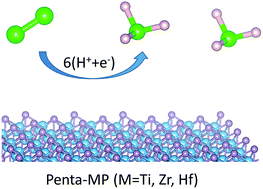Predicting two-dimensional pentagonal transition metal monophosphides for efficient electrocatalytic nitrogen reduction†
Abstract
Electrocatalytic reduction of nitrogen (N2) to ammonia (NH3), as an alternative to traditional energy-consuming Haber–Bosch nitrogen fixation, is a fascinating yet challenging topic. Here, we design a novel group of materials—two-dimensional (2D) pentagonal transition metal phosphides (penta-MP, M = Ti, Zr, Hf)—and study their potential applications in the nitrogen reduction reaction (NRR). Penta-MP are predicted to be dynamically, thermally, and mechanically stable through density functional theory calculations and ab initio molecular dynamics simulations. Their quasi-planar structures and metallic properties facilitate strong N2 adsorption on the surface. The Gibbs free energy diagram suggests that the NRR on penta-MP prefers the distal reaction mechanism, with a low overpotential of 0.56 eV for penta-TiP, which is beneficial for efficient electrocatalytic NRR. Our findings open up a new avenue for designing novel 2D materials as well as electrocatalysts.



 Please wait while we load your content...
Please wait while we load your content...